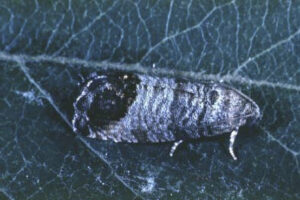Codling Moth: 2nd Generation Begins. July 19th, 2021

‘Summertime….and the living is easy’; with exceptions made for fruit growers.
Brief: The second of potentially three generations of Codling Moth (CM) Order Lepidoptera, Family Tortricidae is beginning this week with adult emergence and flight, occurring on the 18th July (Biofix). Egg laying and larval hatch is expected within the next 10-14 days. Apple Maggot have been on the wing since mid-June, reaching threshold in some blocks. Applications for Apple Maggot has already begun in many orchards based on yellow card or red sphere thresholds. Japanese beetle have been increasing in numbers with fruit feeding observed in Ginger Gold and HoneyCrisp. Increasing presence of wooly apple aphid will also need to be addressed in many orchards as they move from canopy into fruit clusters. The increasing canopy and presence of colonies within fruit clusters will further conceal these pests, management then becoming more of a challenge as we near harvest.
Insecticides for codling moth management (CALS PMEP Guidelines)
Introduction: Our ‘Scouting Report on Codling Moth Pheromone Trap Captures’ show increasing flight of the adult males beginning late last week. As of Monday July 19th, the degree day developmental model for 2nd generation codling moth predicts adult emergence at 6% at the Hudson Valley Research Laboratory. The adults are now mating, with egg laying and larva hatch to begin in the mid-Hudson Valley orchards within the next 10-14 days depending on predicted vs actual temperatures.
Each orchard is unique. To determine the presence of CM in your orchard hang at least 1 trap per 10 acre orchard block at the top of the canopy, specifically in blocks in which historic internal lep. damage has occurred. Cornell suggested trap threshold for CM: If > 5 codling moths are caught per trap per week using standard lures, there can be problems in fruit from the upcoming generation. High trap counts are a signal to prepare for CM management. If trap counts continue to exceed threshold throughout the season, maintain insecticide coverage on a 2 week interval. Each generation will require insecticide residue during the period beginning at 1st to completed egg hatch to control the early and most vulnerable stage of larva.
When scouting for fruit injured from the previous 1st generation in late June into July, look for frass at the calyx end of the fruit and or red ringed entry holes along the cheek and shoulder of fruit, often with frass. If you cut open CM injured fruit prior to larval emergence from the fruit, you are likely to find the larva within the carpel seed cavity with seeds partially eaten, nestled in dark brown frass. Core feeding from lesser apple worm and Oriental Fruit Moth larva will not result in seed feeding. San Jose scale also produce a red ring from feeding, however, there will be no hole or frass from SJS.
If populations of CM reside within the orchard or if adults migrate in from abandoned trees along the borders, they are likely to give rise to damaging populations this week. Trapping in your orchard is the best way to determine presence of the insect. Generally, we are seeing very high incidence of CM injury in untreated and organic treated fruit this season with 1st generation resulting in 2-4% in untreated Macoun. Red delicious are a favored variety with CM infesting most available, untreated fruit. We have been hearing from many New England growers regarding an increase in fruit injury from internal worms over the past few years.
Since apple maggot has now reached threshold in high pressure blocks, the selection of management tools to control both codling moth and apple maggot are in order. The neonicotinoid Assail is very effective against both apple maggot and codling as are many other insecticide tools.
Assail used only for CM management can be used effectively at lower rates (4-8 oz./A). However, for AM management, rates should be at the 8.0 oz./A. Restrictions for Assail include:
• Do not make more than 4 applications per season.
• Do not apply more than once every 12 days.
• Do not apply less than 7 days before harvest (PHI = 7 days).
• Do not exceed a total of 0.60 lbs. active ingredient (32.0 ozs. product) per acre
per growing season.
Keep in mind that neonicotinoids provide low mortality to kill the fly as the insect is not likely to ingest the material. (Dr. Reissig provides excellent research on this topic)
Assail does have excellent repellency to keep the fly from stinging the fruit and curative activity in killing the larva providing levels of clean fruit when trialed with OP’s. (See John Wise comments on this topic).
Imidan (Phosmet) is also very effective against both CM & AM. Although Am can be managed with lower rates, CM management should incorporate the high labeled rate.
The pyrethroid group and pre-mix formulations with a pyrethroid will also perform well against this complex.
On some farms in the mid-Hudson Valley, including Highland, Milton and Marlboro, consideration to control the stink bug complex, including the Brown Marmorated Stink Bug (BMSB) would employ a pre-mix or Bifenthrin to manage this additional pest in August.
Insecticide tools with various degrees of efficacy for BMSB management.
We observed the first emergence of Japanese beetle, Popillia japonica over the past two week beginning 4th July in the lower Hudson Valley. However the emergence has been in many sites clustered in small locations and lackluster in numbers compared to previous growing seasons with relatively few beetles causing damage to fruit trees up to this point. Injury to Honeycrisp and Gingergold has been observed last week.Many of the insecticides used to manage apple maggot (such as the OP’s pyrethroids, Delegate & Entrust) will likely reduce foliar & fruit feeding by the June beetle complex.



